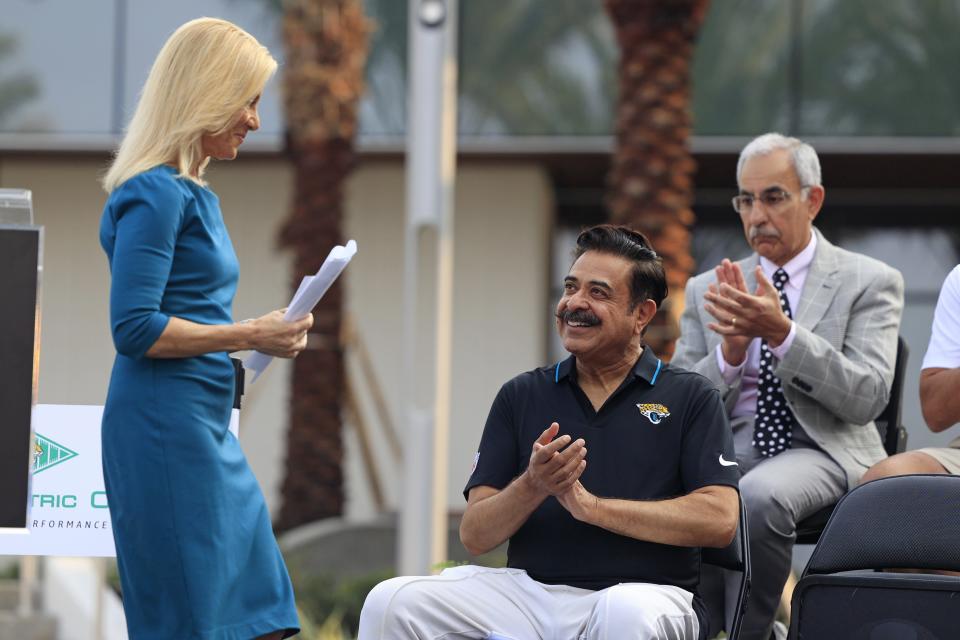Gene Frenette: Optics of Jaguars' stadium renovation agreement with city fair for both sides
When peeling back the onion of the framework for the Jaguars’ stadium renovation agreement with the city of Jacksonville, two pairs of percentage numbers stand out — 50-50 and 55-45.
The first represents the even split between the two parties of $625 million apiece for just the renovation part, then the additional $150 million the city is kicking in for deferred capital and stadium maintenance over 30 years. That drops the Jaguars’ portion of the bill to 45 percent in the overall construction costs.
Why is that important? In one word: optics.
That strategy initiated by Jaguars president Mark Lamping was critical to delivering an agreement both sides could ultimately live with.

For the city, mayor Donna Deegan and her key counsel in negotiations, Mike Weinstein, could claim a victory by getting the Jaguars to agree on a 50-50 split strictly on the stadium renovation part of the deal at $625 million apiece. That is significantly less of a public investment than the Buffalo Bills and Tennessee Titans coaxed from taxpayers to finance their new stadiums, which makes it easier to present to Jacksonville citizens and the City Council.
On the flip side, the benefit for the Jaguars and owner Shad Khan is if this proposal is passed as expected next month by the council, the city adding an extra $150 million toward stadium maintenance makes it practically a slam dunk for approval by NFL owners.
That’s because Lamping can sell it to ownership as Jacksonville being responsible for 55 percent of the total $1.4 billion package, which the Jaguars believe virtually assures passage.
“However Mark [Lamping] wants to sell it to the NFL, that’s perfectly fine with me,” said Deegan. “This is a good deal, a great deal for Jacksonville.”
A necessary compromise
Whether it’s a great deal is a debatable point for many people who struggle to reconcile this being the largest public investment in Jacksonville history, especially when an NFL owner who has more than quadrupled his initial investment in the Jaguars is a huge beneficiary.
A better way to describe this framework agreement, which the council figures to approve by a significant majority on June 24, is a fair compromise.
While Lamping said the city initially wanted the Jaguars to take on more than 50 percent of the renovation costs, which he acknowledged was economically untenable for the team’s overall financial health, Jacksonville’s mayor wasn’t about to let a potential stalemate kill the deal.
“This is an opportunity to meet a moment,” said Deegan. “I don’t believe this is a time for half-measures at this point.”
Deegan understands the costs of ensuring the Jaguars will remain in Jacksonville for at least another 30 years is a hefty price tag. But she wasn’t about to jeopardize the city’s best avenue toward igniting stagnant downtown development, which would be next to impossible if it loses the only major pro sports team and Jacksonville’s largest single investor in Khan.
The Jaguars and Jacksonville need each other. That’s why this deal will get done, even at a price that’s less than ideal for both sides.
Jaguars’ rookie wants Ford Field revenge
Five minutes after the Jaguars picked him in the fourth round, the eyes of offensive tackle Javon Foster brightened when he looked up the schedule on his phone and saw they were playing his hometown Detroit Lions at Ford Field.
His only previous experience at Ford Field is a painful memory for Foster, whose Bloomfield Fields High team lost in the Division I Michigan state championship game to Oakland Red Division rival Clarkston by a stunning 3-2 score in 2017.
Despite outgaining Clarkston in total yardage 285-117, Foster’s team never scored after getting an early safety. The only red-zone penetration for either team came when Bloomfield Hills got inside the 10, but an end-zone pass was intercepted.
Foster hopes to settle that old score, saying: “I want to go back there and get a win this time.”
Too many cooks in SEC broth
Is it any wonder why football programs in the Southeastern Conference have the most resources when examining their bloated coaching staffs?
No less than four schools, including Florida under Billy Napier, have co-coordinators on both sides of the ball. The Gators employ Rob Sale and Russ Callaway as offensive coordinators, with Austin Armstrong and Ron Roberts on defense.
An excessive coaching staff isn’t just confined to Gainesville. Texas, Oklahoma and Alabama each have multiple coordinators on both sides of the ball, with the Crimson Tide under first-year coach Kalen DeBoer inexplicably paying three guys to serve as defensive coordinator.
Kentucky, Missouri, Mississippi State, South Carolina, Tennessee and Vanderbilt are the only schools with the fiscal restraint to employ just one offensive and defensive coordinator.
But for most of the $EC with overflowing revenue streams, spending excessively on football is simply a way of life.
Gfrenette@jacksonville.com: (904) 359-4540; Follow him on X, formerly Twitter, at @genefrenette
This article originally appeared on Florida Times-Union: Mayor Deegan didn't let hefty price tag on Jaguars' stadium renovation get in way

